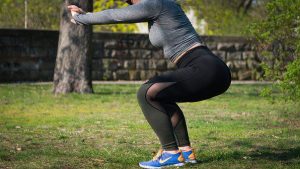Looking for a quick, efficient, fun workout that will increase your fitness? Try HIIT exercises! High-intensity interval training involves short periods of intense exercise followed by easier recovery or rest. Elite athletes have utilized HIIT for decades to improve performance. Recreational athletes are turning to HIIT in droves because of the dramatic results. People of all shapes and sizes are finding that adding HIIT, to their workout routine, can accelerate health goal achievement.
Safety First
 Consult with your physician before undertaking HIIT or any new exercise program especially for those with little aerobic conditioning or underlying health issues including obesity. Include HIIT slowly at first, starting with shorter intervals, at a medium intensity level. As your body adapts to the training, the duration and intensity of the intervals can increase. Record your progress to help avoid over-training and injury. Limit HIIT sessions to 2-3 per week. Complete a thorough warm up before each session of HIIT to allow for the best workout and prevent the risk of injury.
Consult with your physician before undertaking HIIT or any new exercise program especially for those with little aerobic conditioning or underlying health issues including obesity. Include HIIT slowly at first, starting with shorter intervals, at a medium intensity level. As your body adapts to the training, the duration and intensity of the intervals can increase. Record your progress to help avoid over-training and injury. Limit HIIT sessions to 2-3 per week. Complete a thorough warm up before each session of HIIT to allow for the best workout and prevent the risk of injury.
Benefits of HIIT Exercises
- improved aerobic fitness (i.e. heart, lungs, circulation)
- enhanced athletic performance (i.e. muscles strength and ability to contract)
- reduced body fat and increased metabolism
- shortened, more efficient exercise time
- renewed interest in exercise (this isn’t boring)
Basics of HIIT
Two popular HIIT methods include Tabata and the Little Method. Tabata includes 8 cycles of 20 seconds of intense exercise, followed by 10 seconds of recovery, for a total of 4 minutes. The Little Method includes 8-12 cycles of 60 seconds of intense exercise followed by 75 seconds of recover. For HIIT cycles with a longer recovery, make sure to move around with walking etc to aid with recovery. HIIT can also be applied to your walk, treadmill, elliptical or stationary bike workout. Just pickup the pace for the set amount of time, then recover. You can set your own interval too-30 seconds hard, then 30 seconds easy, for 5 cycles.
HIIT is Flexible
HIIT can be applied to many activities. The short amount of time makes it possible to get an amazing workout no matter what your day holds. Committed to your kid’s tournament all weekend? Abandon the doughnut eating parent crowd, find the stairwell, and walk the stairs 10 times, recovering on the way down. HIIT is easy to adapt to machines at the gym, swimming, cycling, walking, and weight lifting. Stuck on hold on your phone? Fit in some HIIT while you wait.
 Beginner HIIT Exercises
Beginner HIIT Exercises
Here is a beginner HIIT workout suggestion for those looking for a low-impact option:
*Start with 5-10 minutes of gentle movement and walking to warm up
3-5 cycles of the following exercises (try upping the intensity for 30 seconds, then resting 30 seconds)
Round 1
- March in place, arms moving with opposite leg
- Side jacks, right arm and leg out to the side, return to start, left arm/leg out to the side
- Front jacks-right leg back, left arm up, switch
- Side bends-hands behind head, feet wider than hip distance, toes pointed out, bent knees, bend towards left knee then right
- Forearm wall plank-step feet out to form at least 45 degree angle with wall
Round 2
- Hamstring curl, raise right leg in back while raising left arm in front
- Side march-feet wider than hips distance, toes pointed out, march left and right, pull arms back with each step
- Wall pushup
- Russian Twist-seated leaning back slightly, clasp hands and twist side to side
- Squats-hinge hips back, butt back, push through heels on the way up
Consider adding HIIT to your 30-minute walk. Walk for 15 minutes, then do a few HIIT cycles, then finish the walk.
HIIT doesn’t just mean burpees, jump rope, and mountain climbers! Try this low-impact HIIT cycle that will give you the same benefits at your level. Kick your fitness into high gear by including high intensity interval training into your routine.
by Christy Coughlin
